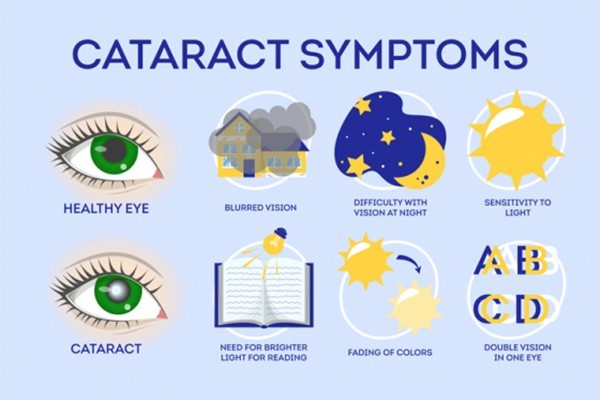A 68-year-old client diagnosed with cataracts should be assessed for which finding?
Blurred or cloudy vision.
Burning sensation in the eye.
Inability to produce tears.
A swollen lacrimal gland.
The Correct Answer is A

Cataracts are a condition where the lens of the eye becomes opaque, causing impaired vision. Blurred or cloudy vision is a common symptom of cataracts.
Some possible explanations for the other choices are:
Choice B. Burning sensation in the eye. This is not a typical symptom of cataracts, but it could indicate an infection, allergy, or dry eye syndrome.
Choice C. Inability to produce tears. This is also not a typical symptom of cataracts, but it could indicate a problem with the lacrimal glands or ducts that produce and drain tears.
Choice D. A swollen lacrimal gland. This is not a symptom of cataracts, but it could indicate an inflammation or infection of the lacrimal gland, which is located near the upper eyelid.
Normal ranges for visual acuity are 20/20 for normal vision and 20/40 for mild impairment. Visual acuity can be measured using a Snellen chart or other methods.
Nursing Test Bank
Naxlex Comprehensive Predictor Exams
Related Questions
Correct Answer is B
Explanation
According to the Addiction Nursing Competencies, antisocial personality traits are one of the risk factors for developing addictive behaviors.
Antisocial personality disorder is characterized by a disregard for the rights and feelings of others, impulsivity, deceitfulness, and lack of remorse.
Choice A is wrong because high self-esteem is not associated with addictive behaviors. On the contrary, low self-esteem, passivity, and inability to relax or defer gratification are some of the personality factors that can predispose a person to substance use disorders.
Choice C is wrong because good communication skills are not related to addictive
behaviors. In fact, poor communication skills, social isolation, and lack of support are some of the psychosocial factors that can contribute to substance use disorders.
Choice D is wrong because aggressive behaviors are not a specific indicator of addictive behaviors.
Aggression can be a result of various factors, such as frustration, anger, stress, or mental illness. Aggression can also be influenced by the type and amount of substance used.
Correct Answer is B
Explanation
120/77 mmHg. This is because this blood pressure reading is within the normal range of less than 120/80 mmHg. Hypertension is defined as a blood pressure of 140/90 mmHg or higher.
Choice A is wrong because 84/50 mmHg is too low and may indicate hypotension, which can cause dizziness, fainting, or shock.
Choice C is wrong because 148/88 mmHg is above the normal range and indicates prehypertension, which is a risk factor for developing hypertension and cardiovascular disease.
Choice D is wrong because 160/90 mmHg is above the normal range and indicates stage 1 hypertension, which requires treatment with lifestyle changes and medication.
Whether you are a student looking to ace your exams or a practicing nurse seeking to enhance your expertise , our nursing education contents will empower you with the confidence and competence to make a difference in the lives of patients and become a respected leader in the healthcare field.
Visit Naxlex, invest in your future and unlock endless possibilities with our unparalleled nursing education contents today
Report Wrong Answer on the Current Question
Do you disagree with the answer? If yes, what is your expected answer? Explain.
Kindly be descriptive with the issue you are facing.
